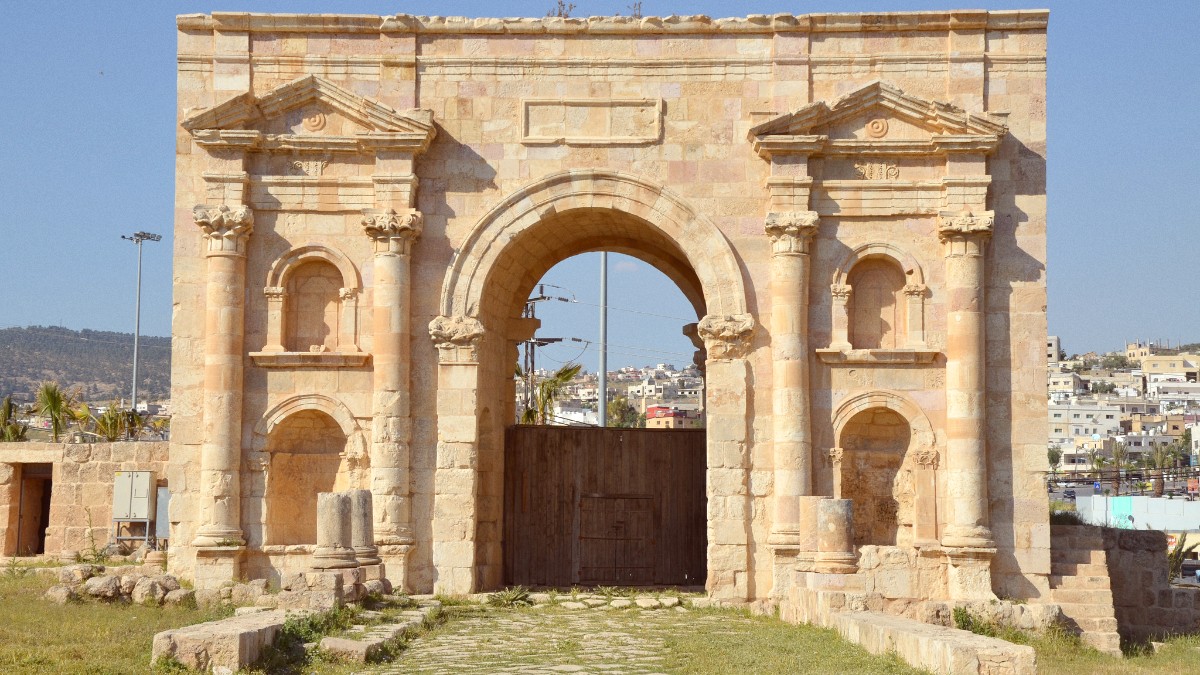
Jerash And The North, Jordan
The closest major international airport to Jerash is Queen Alia International Airport (AMM), approximately 75 kilometers (47 miles) south of Jerash, near Amman. This airport functions as Jordan's main aviation hub. Royal Jordanian, the national carrier, operates flights to and from Amman. Many international airlines also serve AMM, including major carriers like Emirates, Qatar Airways, Turkish Airlines, Lufthansa, British Airways, and low-cost carriers like Ryanair and Wizz Air.
Queen Alia International Airport is a modern facility. It presents duty-free shops, various restaurants and cafes, comfortable lounges, ATMs, currency exchange counters, and major car rental agencies. Free Wi-Fi is available throughout the terminal. For transfers from AMM to Amman, options include the Airport Express Bus (3.50 JOD to Tabarbour), official airport taxis (25-30 JOD to city center), or ride-hailing apps like Careem and Uber. Direct public transport from AMM to Jerash is limited.
Jordan's well-developed road network presents numerous options for land travel, whether arriving from a neighboring country or moving between cities. The most relevant border crossings for tourists are with Israel/Palestine.
Sheikh Hussein Bridge/Jordan River Crossing: Near Irbid, convenient for northern Jordan. Visas on arrival are usually available. King Hussein Bridge/Allenby Bridge: Connects with West Bank. Visas are NOT issued on arrival for non-Palestinian tourists. Wadi Araba Crossing: Near Aqaba, connects with Eilat. Visas on arrival are generally available.
Jordan does not have passenger train services connecting Jerash to other parts of the country. The railway network is mainly for freight. Aqaba, Jordan's only port city on the Red Sea, serves cruise ships and ferry services to and from Nuweiba in Egypt, not relevant for travel directly to Jerash.
Jordanian highways are generally good. The main highway connecting Amman to Jerash is excellent. Road signs are in both Arabic and English.
Local roads in towns can be narrower, less well-maintained, and sometimes have potholes or unmarked speed bumps. Exercise caution and reduce speed.
Practice defensive driving. Honking is common but often used as a signal. Be aware of speed bumps. Driving outside major cities at night can be challenging due to unlit roads and obstacles.
No specific exit fees apply for air travel from Queen Alia International Airport (AMM). However, land border exit fees apply if you leave Jordan by road, notably to Israel/Palestine. For example, the Sheikh Hussein Bridge crossing typically has a 10 JOD exit fee, and the Wadi Araba Crossing near Aqaba charges 8 JOD. Confirm these fees beforehand, as they change.
Allow ample time for border formalities, which involve queues for both exit stamps and security checks. These processes can be unpredictable in duration. Be prepared for potential delays at land crossings, especially during holidays or busy periods. Always check the latest border operating hours and regulations before planning your departure route.
Immigration procedures at Aqaba's seaport are standard, similar to airport entry, for those arriving or departing by cruise or ferry. From Aqaba, you can connect to Amman and other parts of Jordan via long-distance JETT buses, local taxis, or rental cars. The journey from Aqaba to Amman (or Jerash) is several hours by road.
No passenger train services for departure from Jerash. Motorcycle and scooter rentals are less common in Jordan and generally not recommended for touring due to traffic and safety. No formal bicycle sharing programs exist in Jerash. Some hotels might offer bicycles, but cycling on main roads is not advisable. No specialty vehicles like tuk-tuks or jeepneys operate.
Mini-Buses (Servees) are the most common form of local public transport. They are typically white vans operating on fixed routes, departing when full. You hail them from the side of the road or find them at designated stands. JETT buses offer a more comfortable, air-conditioned inter-city service with fixed schedules and fares, mainly connecting major cities. Jerash does not have a metro or tram system.
Taxis offer a convenient way to get around Jerash, especially for shorter distances. Licensed taxis in Jordan are yellow. Always ensure the driver uses the meter. If the meter is broken, negotiate the fare upfront. For rides within Jerash town or to the archaeological site, expect fares of 1-2 JOD. Careem and Uber operate widely in Amman, with a more limited presence in Jerash town.
The entire Jerash archaeological site is pedestrian-only. You will walk extensively over uneven surfaces, ancient cobblestones, and steps. Maps are available at the entrance. Official, licensed site guides are available for hire at the entrance gate.
Jerash has very limited bicycle infrastructure. Cycling on main roads is not recommended due to traffic density, lack of dedicated lanes, and varying road conditions. Stick to quiet rural roads or designated trails in nature reserves if cycling.
Specialized transportation options are limited in Jerash, mainly focusing on organized tours. Many organized day tours from Amman to Jerash use comfortable tour buses. No hop-on-hop-off services operate specifically within Jerash.
Public mini-buses and servees are generally not wheelchair accessible. They have high steps and narrow entrances. This may limit independent travel for those with significant mobility needs. Ride-hailing apps like Careem and Uber might offer more accessible vehicle options in Amman, but their availability in Jerash is limited.
The ancient site of Jerash, with its uneven terrain, loose gravel, steep inclines, and numerous steps, presents significant accessibility challenges for travelers with mobility needs. Some flat areas might be accessible with robust assistance, but full independent access is difficult for wheelchair users. Planning your visit carefully and contacting the site administration for specific accessibility information before arrival is prudent.
Thoroughly research specific sites and transportation options to identify potential barriers.
Reach out to hotels, tour operators, and site administrations directly for detailed accessibility information.
If needed, travel with a companion or arrange for local assistance to navigate challenging areas.
For flexibility, rent a car from Amman. This allows exploration of Jerash at your own pace and combine it with nearby sites like Ajloun and Umm Qais on a single trip.